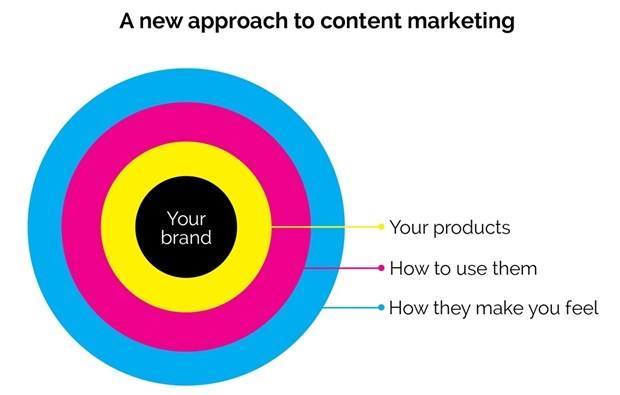





The 'infomercial' approach to branded content on social media and digital channels isn't working for anyone. You cannot claim to be successfully mastering storytelling if your story is: "Our product is the best thing on the planet and is 10% more amazing than everything else. Everyone who bought it lived happily ever after. The end."
Think about the way Dove went from generic soap ads to transforming their brand narrative through the 'Real Beauty' campaign.

To broaden your perspective on branded content, think of your brand as a person - consider what their interests would be and draw your content pillars from that. Compelling storytelling involves removing the product blinkers and looking at the broader context within which your brand exists.
Consider your scope of content as a series of concentric circles. The bigger the circle, the broader the appeal and the greater the potential objective value of the content.
As content marketing becomes the new normal for brands, the reality is setting in that publishing content and having it discovered online are two very different things.
Even the best content needs to be backed by spend to spark engagement and broaden reach. As a result, in 2016 brands will begin to see content distribution strategy as being just as important as content production itself.
Facebook has emerged unequivocally as the most successful paid content distribution platform for brands and publishers alike. With the right targeting strategy and the right content crafting, Facebook is the most effective way to put your content in front of the right people at the right time. And it doesn't hurt that a quarter of all global web traffic is currently channelled through the platform.
That said, brands will also be experimenting with new opportunities for native advertising as publishers explore new mutually beneficial models.
As brands invest in creating higher quality content, they'll also demand a higher standard of analytics to prove ROI. Looking beyond vanity metrics such as impressions and reach, brands will want to measure value by deeper metrics such as time spent on site (and specific articles), comments and, all-important, sharability.
In line with this, it will also be increasingly important to analyse the quality of referral traffic driven by paid content distribution platforms. All of these insights must be fed back into the content production and optimisation process in a constant feedback loop to ensure optimal ROI.
As content takes centre stage, it will become increasingly important for brands wanting to win at content marketing to partner with the professionals. This means working with video production experts when video is required, photographers for amazing imagery and professional writers and journalists for compelling articles.
(Hopefully) gone will be the days of influencer endorsement simply for a once-off fee. Audiences see straight through the one-dimensional 'endorsements' and influencers and brands alike lose credibility because of them. Brands will need to be thinking in terms of long-term, mutually beneficial relationships based on shared values and the desire to create quality content.
